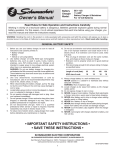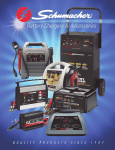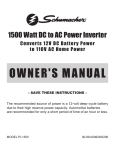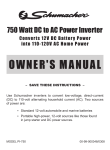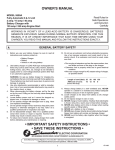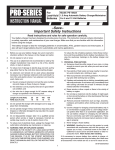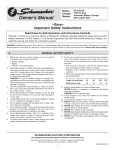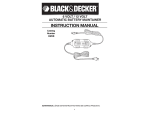Download Schumacher SC-300A Owner`s manual
Transcript
OWNER’S MANUAL Model 300A For 12-Volt Lead-Acid Batteries SpeedCharge ™ Fully Automatic 3 Amp Battery Charger/ Maintainer with Float-Mode Monitoring CAUTION: Read all Safety Rules and Operating Instructions, and follow them with each use of this product. Schumacher Electric Corporation Mount Prospect, IL 60056 U.S.A. Send Warranty Product Repairs to: Customer Service Returns P.O. Box 280,1025 E. Thompson, Hoopeston, IL 60942-0280 Questions? Call Customer Service: 1-800-621-5485 0099000507/1205 TABLE OF CONTENTS IMPORTANT SAFETY INSTRUCTIONS .................................................................... 3 PERSONAL SAFETY PRECAUTIONS ...................................................................... 4 BEFORE USING YOUR BATTERY CHARGER ......................................................... 5 Plugging It In.......................................................................................................... 5 Using An Extension Cord....................................................................................... 5 Battery Clamps....................................................................................................... 5 12v Accessory Plug................................................................................................ 5 Ring Connectors.................................................................................................... 5 USING YOUR BATTERY CHARGER.......................................................................... 6 PREPARING YOUR BATTERY TO BE CHARGED ................................................... 6 OPERATING INSTRUCTIONS ................................................................................... 7 Charging Battery In The Vehicle............................................................................. 7 Charging Battery Removed From The Vehicle....................................................... 8 MAINTENANCE AND CARE ...................................................................................... 8 BATTERY PERCENT AND CHARGE TIME................................................................ 9 LIMITED WARRANTY ................................................................................................ 9 SAVE THIS OWNER’S MANUAL AND READ BEFORE EACH USE. Model 300A, Fully Automatic Battery Charger offers features to accommodate the needs for home or light commercial use. This manual will explain how to use the charger safely and effectively. Please read and follow these instructions and precautions carefully. NOTE: This equipment has been tested and found to comply with the limits for a Class B digital device, pursuant to Part 15 of the FCC Rules. These limits are designed to provide reasonable protection against harmful interference in a residential installation. This equipment generates, uses and can radiate radio frequency energy and, if not installed and used in accordance with the instructions, may cause harmful interference to radio communications. However, there is no guarantee that interference will not occur in a particular installation. If this equipment does cause harmful interference to radio or television reception, which can be determined by turning the equipment on and off, the user is encouraged to try to correct the interference by one or more of the following measures: • Reorient or relocate the receiving antenna. • Increase the separation between the equipment and receiver. • Connect the equipment into an outlet on a circuit different from that to which the receiver is connected. • Consult the dealer or an experienced radio technician for help. Important Safety Instructions WARNING – RISK OF EXPLOSIVE GASES WORKING IN VICINITY OF A LEAD-ACID BATTERY IS DANGEROUS. BATTERIES GENERATE EXPLOSIVE GASES DURING NORMAL BATTERY OPERATION. FOR THIS REASON, IT IS OF UTMOST IMPORTANCE THAT EACH TIME BEFORE USING YOUR CHARGER, YOU READ THIS MANUAL AND FOLLOW THE INSTRUCTIONS EXACTLY. To reduce risk of battery explosion, follow these instructions and those published by battery manufacturer and manufacturer of any equipment you intend to use in vicinity of battery. Review cautionary markings on these products and on engine. save these Instructions • To reduce risk of electrical shock, unplug the charger from the 120V AC electrical wall outlet before attempting any maintenance or cleaning. This manual contains important safety and operating instructions for battery charger Model 300A. • Always charge battery in a well-ventilated area. • WARNING: Handling the cord on this product or cords associated with accessories sold with this product, will expose you to lead, a chemical known to the State of California to cause cancer and birth defects or other reproductive harm. Wash hands after handling. • WARNING: Battery chargers get hot during operation and must have proper ventilation. Air needs to flow around entire charger. Do not set charger on flammable materials like carpeting, upholstery, paper, cardboard, etc. Charger may damage leather, plastic and rubber. • Read all instructions and cautions printed on the battery charger, battery, and vehicle or equipment using battery. Help us help you —— Remember: • Use charger only on lead-acid type rechargeable batteries, such as those used in cars, trucks, tractors, airplanes, vans, RVs, trolling motors, etc. This charger is not intended to supply power to a low voltage electrical system other than in a starter-motor application. Place charger as far away from the battery being charged as the charger cables will permit. Do not expose charger to rain or snow. Never charge a frozen battery. If battery fluid (electrolyte) becomes frozen, bring battery into a warm area to allow battery to thaw before you begin charging. • Never use charger for charging dry cell batteries that are commonly used with home appliances like radios, stereos, remote controls, etc. These batteries may burst and cause personal injury. • Do not disassemble charger. Take it to a qualified service professional if service or repair is required. Incorrect assembly may result in fire or electrical shock. Never allow battery acid to drip on charger when reading specific gravity or filling battery. Never set a battery on top of charger. Never place charger directly above battery being charged. The gases from the battery will corrode and damage the charger. Never touch the battery clamps together when the charger is on. You could cause a spark. Never pull out the plug by the cord when unplugging the charger. Pulling on the cord may cause damage to the cord or the plug. Never operate charger if it has received a hard blow, been dropped, or otherwise damaged. Take it to a qualified professional for inspection and repair. Do not operate the charger if it has a damaged power cord or plug. Have the cord replaced. Be sure to position the charger power cord to prevent it from being stepped on, tripped over, or damaged. Connect and disconnect DC clamps only after removing charger AC power cord from the wall outlet. Do not permit clamps to touch each other. Personal Safety Precautions • Wear complete eye and clothing protection when working with leadacid batteries. appliances. These batteries may burst and cause injury to persons or damage to property. • Make sure that someone is within range of your voice to come to your aid if needed while you work with or are near a lead-acid battery. • Remove all personal metal items from your body such as rings, bracelets, necklaces and watches, while working with a lead-acid battery. A battery can produce a short circuit current high enough to weld a ring (or the like) to metal, causing a severe burn. • Have plenty of fresh water and soap nearby for use in case battery acid contacts your eyes, skin, or clothing. If this happens, wash immediately with soap and water. Then get medical attention. • Take care not to drop any metal tool or metal object onto the battery. This may result in a spark or short circuit across the battery or another electrical device that may cause an explosion. • Avoid touching your eyes while working with a battery. Wear safety glasses. Acid particles (corrosion) may get into your eyes. If this occurs, flush eyes immediately with running cold water for at least 15 minutes. Then immediately get medical attention. • Always operate the battery charger in an open, well-ventilated area. • Never smoke or allow a spark or flame in the vicinity of the battery or engine. Batteries generate explosive gases. • Never charge a frozen battery. • Remove personal metal items such as rings, bracelets, necklaces and watches when working near a lead acid battery. • Neutralize any acid spills thoroughly with baking soda before attempting to clean up. • Use the charger for charging a leadacid battery only. It is not intended to supply power to a low-voltage electrical system other than in an automotive application. Do not use battery charger for charging dry cell batteries that are commonly used with home • If necessary to remove battery from vehicle to charge, always remove grounded terminal from the battery first. Make sure all accessories in the vehicle are off, so as not to cause an arc. BEFORE USING YOUR BATTERY CHARGER It is important to understand the charger’s requirements. This section explains the charger’s electrical requirements and how to prepare a battery for charging. PLUGGING IT IN Your charger requires a 120V AC electrical outlet installed according to all local codes and ordinances. Versatile Quick-Disconnect Harness Snap any of the three connectors into place in seconds: Battery Clamps Connect the clamps to the charger. Follow the Operating Instructions to connect the output clamps to the battery. After a solid electrical connection is made to the battery, plug the power cord into a 120V AC electrical wall outlet. 12V Accessory Plug Charge or maintain your battery without lifting the hood. Connect the 12V adapter to the charger and plug into the 12V accessory outlet. Route the power cord from charger through the vehicle’s open window and plug into a 120V AC electrical wall outlet. Make sure to place charger on a dry, non-flammable surface, like metal or concrete. USING AN EXTENSION CORD The use of an extension cord is not recommended. If you must use an extension cord, please make sure that you follow these guidelines: • Make sure that pins on plug of extension cord are the same number, size, and shape as those of plug on charger. • Check that the extension cord is properly wired and in good electrical condition. • Make sure that the wire size is large enough for its length and for the AC ampere rating, as specified in the chart below. Ring Connectors The ring connectors permanently attach to the battery providing easy access to quickly charge your battery. This application is appropriate for motorcycles, lawn tractors, ATVs and snowmobiles. To permanently attach to a battery, loosen and remove each nut from bolts at battery terminal. Connect the red POSITIVE ring connector ring to the POSITIVE battery terminal. Connect the black NEGATIVE connector ring to the NEGATIVE battery terminal. Replace and tighten the nuts to secure. Take care to keep both wires and plug away from metal and the engine hood. Plug the power cord into a 120V AC electrical wall outlet. MINIMUM RECOMMENDED EXTENSION CORD Length of Cord, in Feet 25 50 100 150 AWG* Size of Cord 18 18 16 14 *AWG=American Wire Gauge Using Your Battery Charger The 300A does not have an ON/OFF switch. The On and Off commands are controlled by plugging the 300A into a 120V AC electrical wall outlet only after battery connections have been made. *Indicates an overload condition caused by shorting of the battery clamps, reverse polarity (hookup) connection to a battery, or charging a problem battery. LED Indicators Charging Charged Check Battery* Amber Green Red Preparing your battery to be charged It is important that you read and follow these guidelines while you are preparing to charge the battery. • Make sure that you have a 12 volt lead-acid battery. Determine voltage of battery by referring to vehicle owner’s manual. Charge battery initially at charger’s lowest rate. • Clean the battery terminals. Be careful to keep corrosion from getting in or around your eyes. • Wear safety glasses. See additional “Personal Safety Precautions” on page 4. • For batteries with removable vent caps, if required, add distilled water to each cell until the battery acid reaches the level recommended by the manufacturer. This will help purge excessive gases from the cells. Be careful not to overfill. If you have a sealed battery with non-removable vent caps, no action is necessary. • Take time to read all of the battery manufacturer’s specific precautions, such as removing or not removing vent caps while charging, and recommended rates of charge. • Be sure that the area around the battery is well ventilated while it is being charged. Gases emitted from the battery can be forcefully blown away by using a piece of cardboard or other nonmetallic material as a fan. • If it is necessary to remove the battery from the vehicle to charge it, always remove the grounded terminal from the battery first. Turn off all vehicle accessories to avoid sparks from occurring. DANGER - Never alter the AC plug provided. If it will not fit the outlet, have a proper outlet installed by a qualified electrician. Improper connection can result in the risk of electrical shock. WARNING ‑ Connect and disconnect the battery clamps only when the AC power cord is disconnected or arcing may result. • NOTE: A marine (boat) battery installed in a boat must be removed and charged on shore. operating instructions IMPORTANT: Follow all safety instructions and precautions when charging your battery. Wear complete eye protection and clothing protection. Charge your battery in a well-ventilated area. Charging Battery In The Vehicle: block, away from the battery (see figure left). DO NOT connect clamp to negative battery post, carburetor, and fuel line or sheet metal part. 1. Avoid personal injury by keeping clear of fan blades, belts, pulleys and other engine parts. 2. Avoid damaging the charger by keeping the power cord and output cords away from the hood, door or moving engine parts. 3. Note the polarity of the battery posts by checking the identification marks on the battery: POSITIVE (POS, P or +) and NEGATIVE (NEG, N or -). The positive post is usually larger than the negative post. 4. Identify which battery post is grounded or connected to the chassis. THIS IS NORMALLY THE NEGATIVE POST. Connecting to a positive-grounded system: Connect the black (NEGATIVE) output clamp to the NEGATIVE post of the battery. Rock and twist the clamp back and forth to be sure a solid electrical connection is made. Then connect the red (POSITIVE) output clamp to a heavy, unpainted metal part of the chassis or engine block, away from the battery. DO NOT connect clamp to positive battery post, carburetor, and fuel line or sheet metal part. 6. Plug power cord into an 120V AC electrical wall outlet. 7. The CHARGING (yellow) LED should light and the charging process should start. If the CHECK (red) LED is on, check for correct cable connections. 8. The charger stops charging automatically after the battery is fully charged. Charge completion is indicated by CHARGED (green) LED and the charger has stopped charging and switched to the Maintain Mode of operation. NEGATIVE GROUNDED SYSTEM 9. To disconnect the charger, unplug the power cord from the 120V AC electrical wall outlet before attempting to disconnect the output clamps. Then, standing away from the battery, remove the output clamp from the chassis or engine block. Finally, remove the output clamp from the battery post. 5. Connecting to a negative-grounded system: Connect the red (POSITIVE) output clamp to the POSITIVE post of the battery. Rock and twist the clamp back and forth to be sure a solid electrical connection is made. Then connect the black (NEGATIVE) output clamp to a heavy, unpainted metal part of the chassis or engine 10.Clean and store the charger in a dry location. Charging Battery Removed From The Vehicle: POSITIVE 4. Position yourself as far away from the battery as possible, and then connect the black (NEGATIVE) output clamp to the free end of the cable. NEGATIVE BATTERY CHARGER BATTERY 24", 6 GAUGE CABLE 5. Plug the power cord into an AC 120V electrical wall outlet. The charger will be set to the Tester Mode for Regular battery type. POWER CORD 6. Press the appropriate control buttons to select the desired charge rate and battery type. The CHARGING (yellow) LED should light and the charging process should start. If the CHECK (red) LED is on, check for correct cable connections. TO GROUNDED POWER OUTLET 1. Note the polarity of the battery posts by checking the identification marks on the battery: POSITIVE (POS, P or +) and NEGATIVE (NEG, N or -). The positive post is usually larger than the negative post. 7. To disconnect the charger, unplug its power cord before attempting to disconnect the charger clamps. Then, standing away from the battery, remove the output clamp from the NEGATIVE battery post. Finally, remove the output clamp from the POSITIVE battery post. 2. Attach at least a 24-inch-long, 6-gauge (AWG), insulated battery cable to NEGATIVE (NEG, N or -) battery post. Rock and twist the clamp back and forth to be sure a solid electrical connection is made. 8. Clean and store the charger in a dry location. 3. Connect the red (POSITIVE) output clamp to the POSITIVE battery post. Rock and twist the clamp back and forth to be sure a solid electrical connection is made. IMPORTANT: Follow all safety instructions and precautions when charging your battery. Wear complete eye protection and clothing protection. Charge your battery in a well-ventilated area. MAINTENANCE AND CARE A minimal amount of care can keep your battery charger working properly for years. 1. Clean the clamps each time you are finished charging. Wipe off any battery fluid that may have come in contact with the clamps to prevent corrosion. 2. Coil the input and output cords neatly when storing the charger. This will help prevent accidental damage to the cords and charger. 3. Occasional cleaning of the case of the charger with a soft cloth will keep the finish shiny and help prevent corrosion. 4. Store the battery charger in a clean and dry location. battery percent and charge time This charger adjusts the charging time in order to charge the battery completely, efficiently and safely. This battery charger has a rated output of 3 ampere. This output will vary with the age and condition of the battery being charged. If battery has only been slightly discharged, it can be charged in less than a few hours. The same battery will take longer to charge if it is very weak. Amp Hour Battery Charger Average Charge Time in Hours 4 1.5 – 2 10 3.5 – 4 20 7–8 30 11 – 12 45 16.5 – 17 60 22 – 23 limited warranty SCHUMACHER ELECTRIC CORPORATION, 801 BUSINESS CENTER DRIVE, MOUNT PROSPECT, ILLINOIS 60056-2179 MAKES THIS LIMITED WARRANTY TO THE ORIGINAL PURCHASER AT RETAIL OF THIS PRODUCT. THIS LIMITED WARRANTY IS NOT TRANSFERABLE. Schumacher Electric Corporation warrants this battery charger for five years from date of purchase at retail against defective material or workmanship. If such should occur, the unit will be repaired or replaced at the option of the manufacturer. It is the obligation of the purchaser to forward the unit together with the original sales receipt, transportation and/or mailing charges prepaid to the manufacturer or its authorized representative. This limited warranty is void if the product is misused, subjected to careless handling, or repaired by anyone other than the manufacturer or its authorized representative. The manufacturer makes no warranty other than this limited warranty and expressly excludes any implied warranty including any warranty for consequential damages. THIS IS THE ONLY EXPRESS LIMITED WARRANTY AND THE MANUFACTURER NEITHER ASSUMES NOR AUTHORIZES ANYONE TO ASSUME OR MAKE ANY OTHER OBLIGATION TOWARDS THE PRODUCT OTHER THAN THIS EXPRESS LIMITED WARRANTY. THE MANUFACTURER MAKES NO WARRANTY OF MERCHANTABILITY OR FITNESS FOR PURPOSE OF THIS PRODUCT AND EXPRESSLY EXCLUDES SUCH FROM THIS LIMITED WARRANTY. SOME STATES DO NOT ALLOW THE EXCLUSION OR LIMITATION OF INCIDENTAL OR CONSEQUENTIAL DAMAGES OR LENGTH OF IMPLIED WARRANTY SO THE ABOVE LIMITATIONS OR EXCLUSIONS MAY NOT APPLY TO YOU. THIS WARRANTY GIVES YOU SPECIFIC LEGAL RIGHTS AND YOU MAY ALSO HAVE OTHER RIGHTS THAT VARY FROM STATE TO STATE. WARRANTY VALIDATION: The enclosed “Warranty Validation Card” must be completed and mailed within 10 days of product purchase to activate this limited warranty. notes 10













